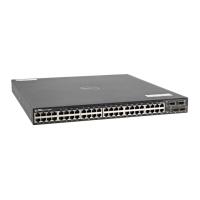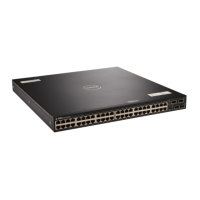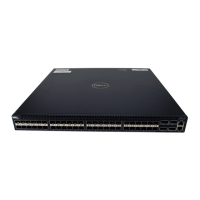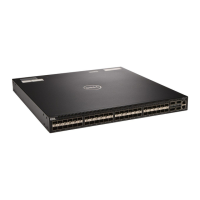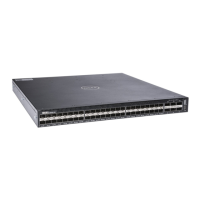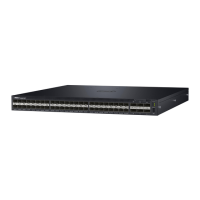– number: the IPv4 address.
The format is A.B.C.D.
NOTE: Enter the router-id for an OSPFv3 router as an IPv4 IP address.
• Disable OSPF.
CONFIGURATION mode
no ipv6 router ospf process-id vrf {vrf-name}
• Reset the OSPFv3 process.
EXEC Privilege mode
clear ipv6 ospf [vrf vrf-name] process
Configuring Stub Areas
To configure IPv6 stub areas, use the following command.
• Configure the area as a stub area.
CONF-IPV6-ROUTER-OSPF mode
area area-id stub [no-summary]
– no-summary: use these keywords to prevent transmission in to the area of summary ASBR LSAs.
– Area ID: a number or IP address assigned when creating the area. You can represent the area ID
as a number from 0 to 65536 if you assign a dotted decimal format rather than an IP address.
Configuring Passive-Interface
To suppress the interface’s participation on an OSPFv3 interface, use the following command.
This command stops the router from sending updates on that interface.
• Specify whether some or all some of the interfaces are passive.
CONF-IPV6-ROUTER-OSPF mode
passive-interface {interface slot/port}
Interface: identifies the specific interface that is passive.
– For a 10-Gigabit Ethernet interface, enter the keyword TenGigabitEthernet then the slot/port
information.
– For a 40-Gigabit Ethernet interface, enter the keyword fortyGigE then the slot/port information.
– For a port channel interface, enter the keywords port-channel then a number.
– For a VLAN interface, enter the keyword vlan then a number from 1 to 4094.
To enable both receiving and sending routing updates, use the no passive-interface interface
command.
To indicate that hello packets are not transmitted on that interface, when you configure a passive
interface, the show ipv6 ospf [vrf vrf-name] interface command adds the words passive
interface.
Open Shortest Path First (OSPFv2 and OSPFv3)
715
